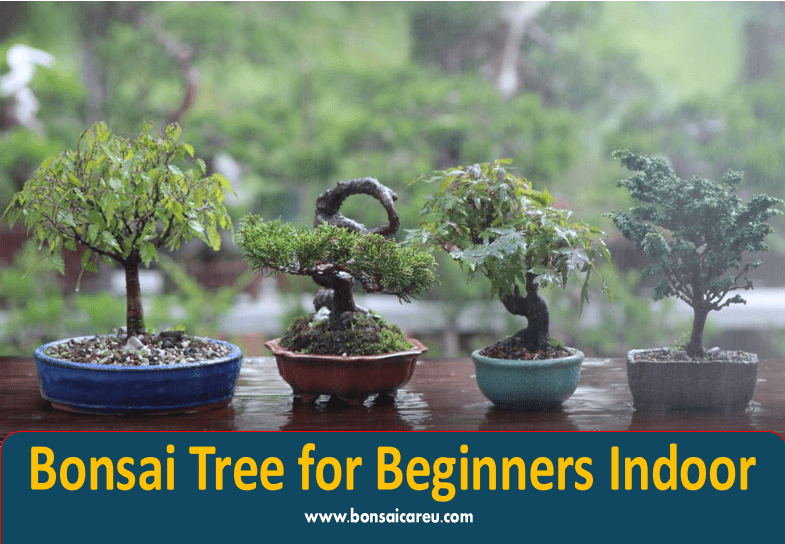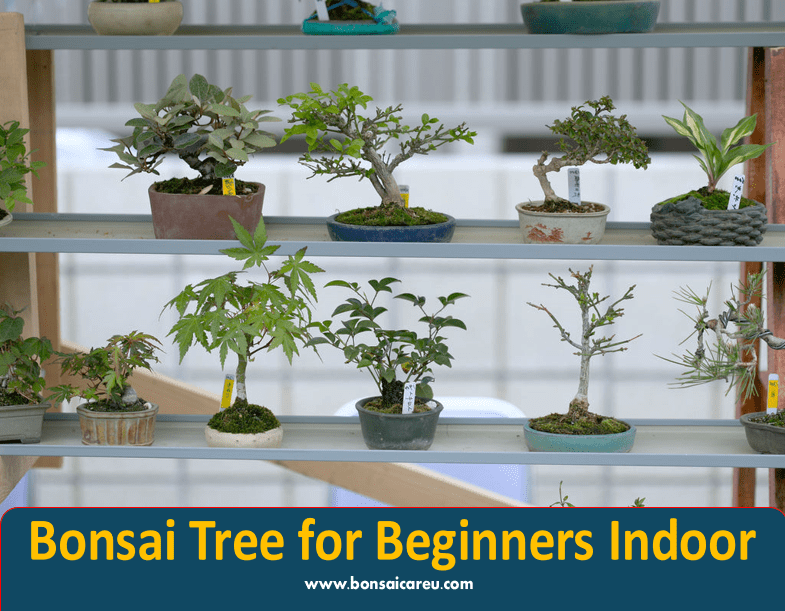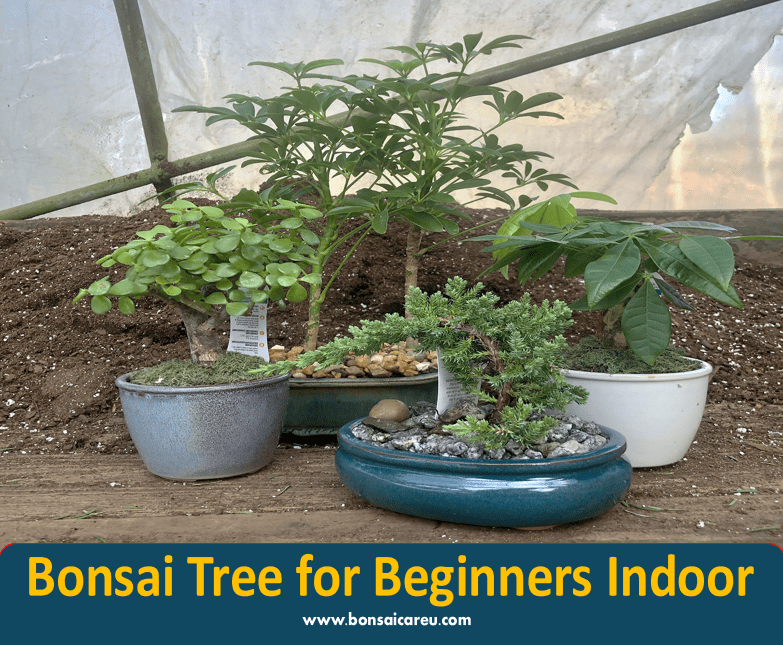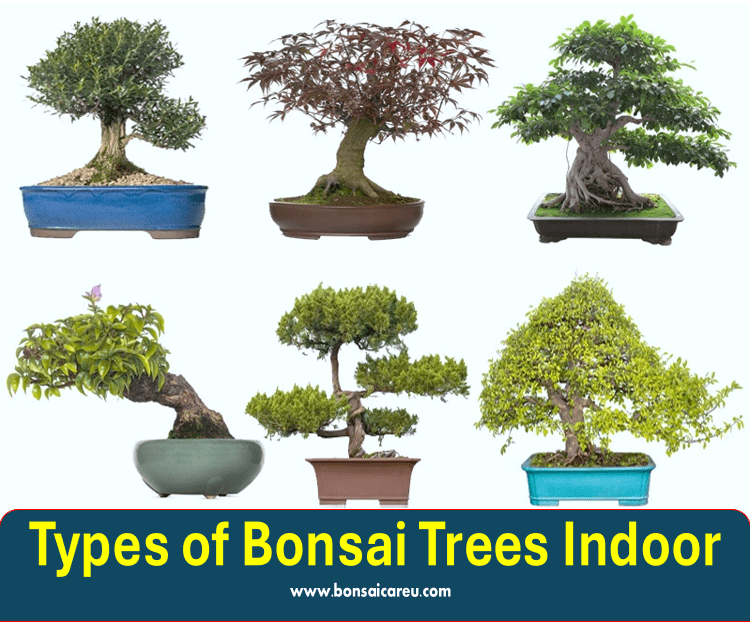Bonsai Tree for Beginners Indoor: Choose a hardy species like ficus or jade for easier maintenance to start with Bonsai trees indoors. Bonsai trees are miniature plants cultivated in shallow containers and require careful attention.
Bonsai trees are not just trees but an art form that originated in China and Japan. Growing a bonsai tree can be a rewarding and therapeutic experience. However, it demands patience, dedication, and knowledge of the specific needs of each species.
When choosing a bonsai tree, consider factors such as experience level, available space, and the time you can devote to its care. Understanding the basics of bonsai care, including watering, pruning, and soil composition, is crucial for the tree’s health. Additionally, providing proper light and humidity levels is essential for its growth. With the right approach, even beginners can successfully grow and enjoy the beauty of bonsai trees indoors.

Choosing The Right Bonsai Tree
When starting your journey with bonsai trees, choosing the right one is crucial for beginners. Understanding the lighting needs, evaluating the size and shape, and researching the care requirements are essential steps in making the right choice.
Consider The Lighting Needs
Bonsai trees have varying lighting requirements. Some thrive in bright, direct sunlight, while others prefer partially shaded areas. When selecting a bonsai tree, it’s important to consider the lighting conditions in your home. Place your bonsai in an area that receives the appropriate light to ensure its healthy growth.
Evaluate The Size And Shape
The size and shape of a bonsai tree often reflect its age and style. Consider the available space in your home and the desired aesthetic when choosing the right bonsai tree. Compact varieties are ideal for indoor settings, while certain styles, such as cascading or upright, may require more vertical space.
Research The Care Requirements
Each bonsai tree has specific care requirements regarding watering, feeding, and pruning. Before making a choice, it is essential to research the care needs of the bonsai tree you’re interested in. Understanding the level of maintenance required will help you make an informed decision that fits your lifestyle.
Preparing The Indoor Environment
When caring for a bonsai tree indoors, preparing the indoor environment is crucial for its growth and health.
Find A Suitable Location
- Choose a spot that receives indirect sunlight to prevent burning the leaves.
- Ensure the area is away from drafts and extreme temperature changes.
- Avoid placing the bonsai near heating or cooling vents.
Create The Ideal Temperature And Humidity
- Maintain a temperature range of 60-75°F for most bonsai trees.
- Increase humidity by using a humidity tray or a small room humidifier.
Provide Adequate Air Circulation
Allow for proper ventilation around the bonsai tree to prevent stagnant air.
Rotate the plant occasionally to ensure even exposure to light and air.
Selecting The Proper Pot And Soil
When it comes to cultivating bonsai trees indoors, selecting the right pot and soil is crucial for the health and growth of your miniature tree. This section will guide you through choosing the proper pot size, selecting the appropriate soil type, and ensuring good drainage for your bonsai tree.
Choose The Right Pot Size
For beginners, choosing a pot proportionate to the size of your bonsai tree is important. The pot should be about one-third the height of the tree to provide ample room for root growth.
Select The Appropriate Soil Type
When selecting soil for your indoor bonsai tree, choose a well-draining mix that promotes healthy root development. A mixture of akadama, pumice, and lava rock is ideal for most bonsai trees.
Ensure Good Drainage
Good drainage is essential to prevent root rot and ensure the overall health of your bonsai tree. Ensure your pot has adequate drainage holes at the bottom to allow excess water to escape freely.

Watering And Feeding Techniques
Bonsai trees are a beautiful and fulfilling hobby for beginners, allowing them to create miniature works of art in their homes. However, to ensure the health and longevity of these exquisite plants, it is crucial to understand the proper watering and feeding techniques. By carefully managing the watering frequency and utilizing the right feeding practices, beginners can set their bonsai trees on the path to thriving and flourishing. This section will delve into the essential aspects of watering and feeding techniques for bonsai trees, providing valuable insights for those just starting their bonsai journey.
Determine The Correct Watering Frequency
Determining the correct watering frequency for your bonsai tree is crucial to its well-being. Each tree species has unique requirements, and its environment plays a key role in determining how often it should be watered. Factors such as humidity levels, soil composition, and the size of the container all contribute to the watering frequency. It is essential to research the specific needs of your bonsai tree species and observe the soil’s moisture level to establish the optimal watering schedule.
Use The Proper Watering Technique
Using the proper watering technique is essential for the health of your bonsai tree. When watering, ensure the soil is thoroughly soaked while allowing excess water to drain. Avoid shallow watering, which may lead to uneven hydration and root issues. Watering the tree from above is advisable, ensuring the water reaches all parts of the soil and not just the surface. Additionally, consider using a water can with a narrow spout to control the flow and direction of the water, preventing disturbance to the soil and tree structure.
Fertilize Regularly With Balanced Nutrients
Fertilizing regularly with balanced nutrients is crucial to providing your bonsai tree with essential elements for growth and vitality. Utilize a high-quality, balanced fertilizer specifically formulated for bonsai trees. Applying the fertilizer during the growing season, typically from spring to autumn, is essential to support the tree’s nutritional needs. However, be cautious not to over-fertilize, as it may lead to chemical burns and harm the tree’s health. Following the recommended dosage and frequency of application according to the fertilizer instructions is key to promoting the bonsai tree’s strength and resilience.
Pruning And Shaping Your Bonsai
Bonsai trees are a fascinating hobby that allows you to create miniature versions of majestic trees. One of the key aspects of bonsai care is pruning and shaping your bonsai tree. Pruning helps maintain your tree’s desired size and shape, while shaping allows you to express your creativity and create a unique bonsai style. This section will explore the principles of pruning, proper pruning techniques, and how to shape your bonsai tree to your desired style.
Understand The Principles Of Pruning
Before you grab your pruning shears, it is important to understand the principles behind pruning a bonsai tree. Pruning is not just about randomly cutting branches. It requires careful consideration of the overall structure and health of the tree. When pruning, keep these principles in mind:
- Remove dead, damaged, or diseased branches to promote the tree’s health.
- Thin out dense areas to allow light and air to reach all parts of the tree.
- Remove branches that cross or rub against each other to prevent damage and encourage proper growth.
- Prune back branches to maintain the desired shape and size of the bonsai.
Follow Proper Pruning Techniques
Proper pruning techniques are vital to the health and aesthetics of your bonsai tree. Here are some guidelines to follow when pruning:
- Start by assessing the overall structure and shape of your bonsai tree. Identify areas that need pruning.
- Use clean and sharp pruning shears to make precise cuts. Sterilize the tools before and after use to prevent the spread of diseases.
- Make clean cuts just above a bud or a pair of buds. Angling the cut away from the tree will help prevent water accumulation and minimize disease risk.
- For larger branches, use concave cutters to create a smooth cut that will heal more quickly.
- Regularly inspect the tree for new growth and adjust your pruning routine accordingly.
Shape The Tree To Your Desired Style
Shaping your bonsai tree is an opportunity to showcase your artistic vision. Each bonsai style has its distinctive characteristics, such as formal upright, informal upright, slanting, cascade, or windswept. Follow these steps to shape your bonsai tree to your desired style:
- Study and understand the characteristics of the bonsai style you wish to achieve.
- Identify the key branches that will form the basis of your bonsai’s structure.
- Gradually prune and train the branches to conform to the desired style. This may involve wiring or using other shaping techniques.
- Regularly observe and adjust the shape of your bonsai to maintain its desired style.
- Remember that shaping a bonsai is an ongoing process that requires patience and attention to detail.

Pest Control And Disease Prevention
Pest control and disease prevention are vital for keeping your bonsai tree healthy. By understanding common pests and diseases, implementing preventive measures, and taking immediate action when problems arise, you can ensure the longevity of your indoor bonsai tree. This section will explore these three essential steps to help you maintain a vibrant and thriving bonsai tree.
Identify Common Pests And Diseases
Identifying common pests and diseases is the first step in effectively controlling them. Here are some of the most common problems you may encounter with your indoor bonsai:
Pests
- Spider mites: These tiny pests can cause discoloration and webs on your bonsai’s leaves.
- Aphids: These small insects feed on the sap of your bonsai and can weaken the plant.
- Scale insects: These pests attach to the leaves and stems of your bonsai, sucking out essential nutrients.
Diseases
- Fungal infections: Fungi can cause leaf spots, wilting, and decay on your bonsai.
- Root rot: Overwatering or poorly draining soil can lead to root rot, which can harm the overall health of your bonsai.
- Leaf blight: This disease causes browning and withering of the leaves on your bonsai tree.
Implement Preventive Measures
Preventing pests and diseases from infesting your bonsai tree is more effective than treating them once they appear. Here are some preventive measures you can take:
Provide proper care and maintenance
- Keep your bonsai tree clean by removing dead leaves and debris regularly.
- Water your bonsai tree properly, allowing the soil to dry slightly between waterings.
- Ensure your bonsai is placed in a suitable environment with adequate sunlight and airflow.
Monitor your bonsai tree closely.
- Regularly inspect your bonsai’s leaves, branches, and trunk for signs of pests or diseases.
- Check the soil moisture level to prevent overwatering or under-watering.
Take Immediate Action When Problems Arise
If you notice any signs of pests or diseases on your bonsai tree, it is crucial to take immediate action. Here’s what you can do:
Isolate and treat the affected area
- If you identify pests or diseases on your bonsai, isolate the affected tree to prevent spreading.
- Treat the affected area with organic insecticides or fungicides, following the instructions carefully.
Consult an expert
- If the problem persists or worsens, consult a bonsai expert for proper diagnosis and treatment.
- They can provide guidance on specific remedies and care techniques tailored to your bonsai tree.
By staying vigilant and taking necessary preventive measures, you can minimize the risk of pests and diseases affecting your indoor bonsai tree. Regular monitoring, immediate action, and expert advice will help you maintain a healthy and beautiful bonsai for years.
Frequently Asked Questions For Bonsai Tree For Beginners Indoor
What Is The Easiest Bonsai Tree To Keep Indoors?
The Ficus Bonsai is the easiest tree for indoor care due to its adaptability and low maintenance requirements.
Which Is The Best Bonsai Tree For Beginners?
The best bonsai tree for beginners is the Ficus Retusa or Chinese Elm. These trees are easy to care for, adaptable, and forgiving of beginner mistakes. They thrive indoors and are ideal for learning the art of bonsai cultivation.
Are Bonsai Trees Good For the Indoor?
Yes, Bonsai trees are suitable for indoor environments. They bring beauty and tranquility to your home and can thrive with proper care and maintenance.
How Do I Start My First Bonsai Tree?
To start your first bonsai tree, follow these steps: 1. Choose a suitable tree species for bonsai. 2. Find a pot and soil specifically for bonsai. 3. Trim the tree’s roots and shape the branches. 4. Water regularly, but don’t overwater.
5. Place in a location with adequate sunlight and temperature.
What Is The Best Bonsai Tree For Beginners?
For beginners, we recommend starting with a Ficus or Jade bonsai tree. They are hardy and easy to care for indoors.
How Often Should I Water My Indoor Bonsai Tree?
Water your indoor bonsai tree when the top soil feels dry to the touch, typically 1-2 times per week, depending on the tree species.
Conclusion
A bonsai tree is a great choice for beginners seeking an indoor plant. With the right care and attention, it can thrive in any living space and bring joy and tranquility. Whether you want to enhance your décor or connect with nature, a bonsai is an excellent addition to any home.


